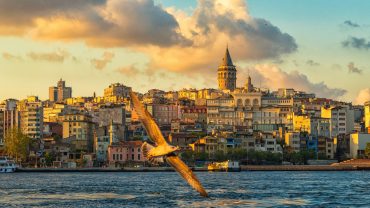
Şırnak is a town in southeastern Turkey. It is the capital of Şırnak Province, a new province that split from the Hakkari province. The Habur border gate with Iraq which is one of Turkey’s main links to Middle Eastern countries is also on Şırnak.
Names
The settlement was originally called Şehr-i Nuh (City of Noah) since it was near Cudi Mountain where Noah’s Ark finally believed to have landed after the Flood.
History
During the Guti Empire’s reign in the region, a special inscription style called “civi zend” was invented. Mount Cudi, surrounded by other mountains to the east and northeast and plains to the west and southwest has a unique place in history. It is the mountain on which Noah’s Ark is believed to have landed. One of its peaks, at over 2000 meters, is “Noah’s Visit” (some Islamic scholars argue that Noah landed on Cudi mountain).
Other historical assets of Şırnak include a rock carving from the Assyrians describing a figure on horseback (in Meseici village near Kasrik Pass); other rock carvings dating back to the Neolithic Age which corresponds to 7000 BC (in Beytüşşebap); fortresses of Kale, Meme Kale and Kaletivuru; bridges of the Kasrik Pass which reflect the art stone working in the time of Seljuks; and Virgin Mary Church in Cizre (not to be confused with the one in Ephesus).
Bus Companies
Şırnak to Istanbul Europe buses are provided by Star Mardin Turizm, Cizre Nuh İtimat and Mardin Seyahat.
Stations & Stops
For a bus leaving from Şırnak, the trip starts at Şırnak Otogarı or Sirnak Otogari Duragi.
In Istanbul Europe, your bus travel ends at İstanbul, Esenler Otogarı, Harem Otogarı, Alibeyköy Otogarı, Atakent, 42 Evler (İstanbul), 4.Levent, Ahmediye, Aksaray or Aksaray.
PLACES TO VISIT
Finik Ruins and Citadel: The ruins dating back to 4000 BC are in Cizre. It is located opposite the Duzova and İdil Hendek villages on the banks of the Tigris River in the town of Guçlukonak. Here are relief sculptures of Assyrians and Gutis. Water cisterns, rock carved houses and women’s paintings, hidden water stairs are the most important works.
Babil Ruins : The surroundings of Babil Ruins are located in Kebeli village, 20 km southwest of Cizre, on the Syrian border, surrounded by rectangular walls. There are approximately 30 towers in these walls forming the outer fortress. The inner castle is in the form of a circle. The walls are made of uncorked basalt rocks and the structures are made of white limestone.
Cizre Kırmızı Madrasah : It was built in the XIV. Century by II. Han Seref Bey during the period of Cizre principality . The madrasah has a courtyard, and there are classrooms, dining hall and teacher lodges in the east and west. Its altar is made of white stone and measures 2.82 x 3.78. The madrasa is called the Red Madrasa because it is built from red bricks unique to Cizre.
Cizre Castle: Cizre Castle and Walls of Cizre were built by the Guti Empire in 4000 BC. Cizre Castle is on the banks of the Tigris River in the north of the city. The fort consists of outer walls and inner walls. The castle, which can be followed during the Roman and Byzantine periods , has survived from the XII. century to the XVI. century, as it took during the Mosul Atabeks and Cizre Beys.
Tomb of the Prophet Noah : After the death of the Prophet Noah, who settled in Cizre after the great flood , he was buried in Dagkapı. There is a grave in the basement of the mosque in the southern part of Nuh Mosque. It was first converted into a synagogue, then a church, and a mosque in 639.
Abdaliye Madrasa: It is between the Cizre Dagkapı and the cemetery. It was built in 1437 by Emir Abdullah (Abdal) Ibn Abdillah Ibn Seyfeddin Boti, one of the beys of Cizre . He is the father of Emir Zeynuddin, who was involved in the Mem-u Zin incident. Mem-u Zin shrines are located in the south under the administrative chambers, the owners of the world-famous love story.
Virgin Mary Church: The church, built in 57 AD, is located in İdil district of Sırnak province. The church belonging to the Syriac Orthodox community is active. A bell fortress was added later.
TOURISM
Sırnak province has important touristic attractions with its rich history, cultural resources and natural values. In the province where the development in the tourism sector is not sufficient, tourism and recreation facilities have not developed at the desired level in terms of quality and quantity. The historical monuments, natural beauties and other sights worth seeing in the city cannot be evaluated properly due to the lack of sufficient infrastructure and tourist investments. One of the most important tourist values is Mount Cudi.
Cudi Mountain: One of the first names that come to mind when it comes to Şırnak, the mountain has been the subject of many historical stories and has hosted many civilizations. It is believed that Noah’s ark also landed on this mountain. Mount Cudi is also an area suitable for trekking and hiking .
River Tourism (Canoe-Rafting) : The Tigris River, which is fed by Kızılsu, Habur and Hezil streams, which is the most important river of the province, is suitable for river tourism.





Comment (0)